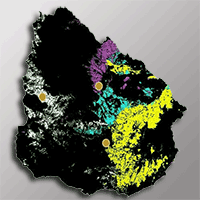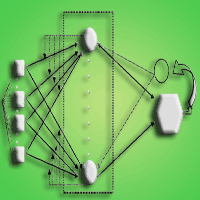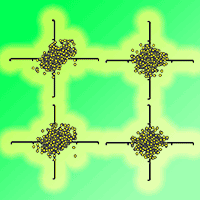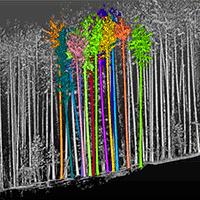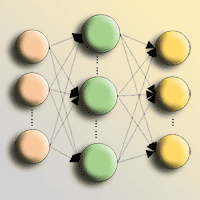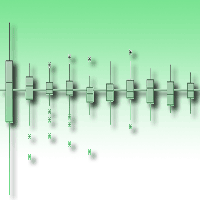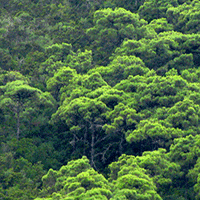The taper and merchantable tree volume equations are the most used models in forestry because of their accuracy in estimating both total and merchantable tree volume. However, numerous studies reported that artificial neural network models show fewer errors and a greater success rate as compared to regression models. This study used data from 200 Crimean pine trees in Turkey’s Central Anatolia and Mediterranean Region to assess the performance of artificial neural network (ANN) models and the Max-Burkhart’s equation for estimating taper and merchantable tree volume. The most accurate results were obtained using 3 hidden layers and 10 neurons in the taper model and 1 hidden layer and 100 neurons in the volume model. The hyperbolic tangent sigmoid function was used for the ANN analysis and hyper-parameter customization. Using the ANN model with hyper-parameter customization, the AAE in the Max-Burkhart taper model decreased from 9.315 to 6.939 (-25.5%), the RMSE decreased from 3.072 to 2.656 (-13.5%), and the FI increased from 0.964 to 0.966 (+1.23%). Similarly, using the ANN model with hyper-parameter customization, the AAE in the Max-Burkhart volume model decreased from 0.056 to 0.013 (-76.6%), the RMSE decreased from 0.247 to 0.12 (-51.6%), and the FI increased from 0.909 to 0.979 (+7.69%). Our results showed that the ANN models’ predictions were more accurate and reliable compared to the Max-Burkhart’s equations. We resolved overfitting via hyper-parameter modification, which also allowed for monitoring the impact of error and prediction outputs at various learning rates. It was also possible to develop tree taper and volume equations with lower error rates in both training and validation data, consistent with tree growth trends in both data sets.
Keywords
, , , ,
Citation
Sahin A (2024). Analyzing regression models and multi-layer artificial neural network models for estimating taper and tree volume in Crimean pine forests. iForest 17: 36-44. - doi: 10.3832/ifor4449-017
Academic Editor
Rodolfo Picchio
Paper history
Received: Aug 14, 2023
Accepted: Jan 04, 2024
First online: Feb 28, 2024
Publication Date: Feb 29, 2024
Publication Time: 1.83 months
© SISEF - The Italian Society of Silviculture and Forest Ecology 2024
Open Access
This article is distributed under the terms of the Creative Commons Attribution-Non Commercial 4.0 International (https://creativecommons.org/licenses/by-nc/4.0/), which permits unrestricted use, distribution, and reproduction in any medium, provided you give appropriate credit to the original author(s) and the source, provide a link to the Creative Commons license, and indicate if changes were made.

Breakdown by View Type
(Waiting for server response...)
Article Usage
Total Article Views: 7398
(from publication date up to now)
Breakdown by View Type
HTML Page Views: 2413
Abstract Page Views: 2211
PDF Downloads: 2491
Citation/Reference Downloads: 2
XML Downloads: 281
Web Metrics
Days since publication: 656
Overall contacts: 7398
Avg. contacts per week: 78.94
Article Citations
Article citations are based on data periodically collected from the Clarivate Web of Science web site
(last update: Mar 2025)
Total number of cites (since 2024): 2
Average cites per year: 1.00
Publication Metrics
by Dimensions ©
Articles citing this article
List of the papers citing this article based on CrossRef Cited-by.
(1)
Ashraf MI, Zhao Z, Bourque A, MacLean DA, Meng F (2013)Integrating biophysical controls in forest growth and yield predictions generated with artificial intelligence technology. Canadian Journal of Forest Research 43 (12): 1162-1171.
CrossRef |
Gscholar
(2)
Avery TE, Burkhart HE (1983)Forest Measurement (3rd edn), Mcgraw-Hill, New York, USA, pp. 331.
Gscholar
(3)
Bolat F, Ercanli I, Günlü A (2023)Yield of forests in Ankara Regional Directory of Forestry in Turkey: comparison of regression and artificial neural network models based on statistical and biological behaviors. iForest - Biogeosciences and Forestry 16 (1): 30-37.
CrossRef |
Gscholar
(4)
Cutini A, Chianucci F, Manetti MC (2013)Allometric relationships for volume and biomass for stone pine (
Pinus pinea L.) in Italian coastal stands. iForest - Biogeosciences and Forestry 6 (6): 331-335.
CrossRef |
Gscholar
(5)
Davis LS, Johnson K, Bettinger P, Howard T (2001)Forest management: to sustain ecological, economic, and social values (4th edn). Waveland Press, IL and McGraw-Hill, Boston, MS, USA, pp. 804.
Gscholar
(6)
De-Miguel S, Mehtätalo L, Shater Z, Kraid B, Pukkala T (2012)T. Evaluating marginal and conditional predictions of taper models in the absence of calibration data. Canadian Journal of Forest Research 42 (7): 1383-1394.
CrossRef |
Gscholar
(7)
Diamantopoulou MJ (2005)Predicting fir trees stem diameters using artificial neural network models. Southern African Forestry Journal 205 (1): 39-44.
CrossRef |
Gscholar
(8)
Diéguez-Aranda U, Castedo-Dorado F, Alvarez González JG, Rojo A (2006)Compatible taper function for Scots pine plantations in northwestern Spain. Canadian Journal of Forest Research 36 (5): 1190-1205.
CrossRef |
Gscholar
(9)
Ercanli I (2020a)Artificial intelligence with deep learning algorithms to model relationships between total tree height and diameter at breast height. Forest Systems 29 (2): e013-e013.
CrossRef |
Gscholar
(10)
Ercanli I (2020b)Innovative deep learning artificial intelligence applications for predicting relationships between individual tree height and diameter at breast height. Forest Ecosystems 7 (1): 1-18.
CrossRef |
Gscholar
(11)
Ercanli I, Senyurt M, Bolat F (2022)A major challenge to machine learning models: compatible predictions with biological realism in forestry: a case study of individual tree volume. In: Proceeding of the “3rd International Conference on Environment and Forest Conservation (ICEFC)”. Kastamonu (Turkey) 21-23 Feb 2022, pp. 39.
Gscholar
(12)
Gregoire TG, Schabenberger O, Barrett JP (1995)Linear modeling of irregularly spaced, unbalanced, longitudinal data from permanent-plot measurements. Canadian Journal of Forest Research 25 (1): 137-156.
CrossRef |
Gscholar
(13)
Guan BT, Gertner G (1991)Modeling red pine tree survival with an artificial neural network. Forest Science 37 (5): 1429-1440.
Online |
Gscholar
(14)
Haykin SS (2009)Neural networks and learning machines (3rd edn). Pearson Education, Upper Saddle River, NJ, USA, pp. 936.
Gscholar
(15)
H2O.ai (2018)H2O R Package Documentation. Web site.
Online |
Gscholar
(16)
Kozak A (1988)A variable-exponent taper equation. Canadian Journal of Forest Research 18 (11): 1363-1368.
CrossRef |
Gscholar
(17)
Kozak A (1997)Effects of multicollinearity and autocorrelation on the variable-exponent taper functions. Canadian Journal of Forest Research 27 (5): 619-629.
CrossRef |
Gscholar
(18)
Kozak A (2004)My last words on taper equations. The Forestry Chronicle 80 (4): 507-515.
CrossRef |
Gscholar
(19)
Leites LP, Robinson AP (2004)Improving taper equations of loblolly pine with crown dimensions in a mixed-effects modeling framework. Forest Science 50 (2): 204-212.
Online |
Gscholar
(20)
Littell RC, Miliken GA, Stroup WW, Wolfinger RD (2006)SAS system for mixed models (2nd edn). SAS Institute Inc., Cary, NC, USA, pp. 814.
Gscholar
(21)
Loetsch F, Zöhrer F, Haller KE (1973)Forest Inventory. BLV-Verlagsgesellschaft, München, Germany, vol. 2, pp. 469.
Gscholar
(22)
López-Sánchez CA, Rodríguez-Soalleiro R, Castedo-Dorado F, Corral-Rivas S, Alvarez-González JG (2016)A taper function for
Pseudotsuga menziesii plantations in Spain. Southern Forests 78 (2): 131-135.
CrossRef |
Gscholar
(23)
Max TA, Burkhart HE (1976)Segmented polynomial regression applied to taper equations. Forest Science 22 (3): 283-289.
Online |
Gscholar
(24)
Mushar SHM, Ahmad SSS, Kasmin F, Shari NHZ (2020)Machine learning approach for estimating tree volume. Journal of Physics: Conference Series 1502 (1): 012039.
CrossRef |
Gscholar
(25)
Nasr GE, Badr EA, Joun C (2003)Backpropagation neural networks for modeling gasoline consumption. Energy Conversion and Management 44 (6): 893-905.
CrossRef |
Gscholar
(26)
Newnham RM (1992)Variable-form taper function for four Alberta tree species. Canadian Journal of Forest Research 22: 210-223.
CrossRef |
Gscholar
(27)
Nunes MH, Görgens EB (2016)Artificial intelligence procedures for tree taper estimation within a complex vegetation mosaic in Brazil. PLoS One 11 (5): e0154738.
CrossRef |
Gscholar
(28)
Nwankpa C, Ijomah W, Gachagan A, Marshall S (2018)Activation functions: comparison of trends in practice and research for deep learning. arXiv [preprint]: 1811. 03378.
Online |
Gscholar
(29)
Ogana FN, Ercanli I (2021)Modelling height-diameter relationships in complex tropical rain forest ecosystems using deep learning algorithm. Journal of Forestry Research 33 (3): 883-898.
CrossRef |
Gscholar
(30)
Ozçelik R, Diamantopoulou MJ, Brooks JR, Wiant HV (2010)Estimating tree bole volume using artificial neural network models for four species in Turkey. Journal of Environmental Management 91 (3): 742-753.
CrossRef |
Gscholar
(31)
Ozçelik R, Diamantopoulou MJ, Crecente-Campo F, Eler U (2013)Estimating Crimean juniper tree height using nonlinear regression and artificial neural network models. Forest Ecology and Management 306: 52-60.
CrossRef |
Gscholar
(32)
Ozçelik R, Diamantopoulou MJ, Brooks JR (2014)The use of tree crown variables in over-bark diameter and volume prediction models. iForest - Biogeosciences and Forestry 7 (3): 132-139.
CrossRef |
Gscholar
(33)
Ozçelik R, Crecente-Campo F (2016)Stem taper equations for estimating merchantable volume of Lebanon cedar trees in the Taurus Mountains, Southern Turkey. Forest Science 62 (1): 78-91.
CrossRef |
Gscholar
(34)
Poudel KP, Temesgen H, Gray NA (2018)Estimating upper stem diameters and volume of Douglas-fir and Western hemlock trees in the Pacific northwest. Forest Ecosystems 5: 16.
CrossRef |
Gscholar
(35)
Pretzsch H (2009)Forest dynamics, growth and yield. Springer, Berlin, Heidelberg, Germany, vol. 684, pp. 664.
CrossRef |
Gscholar
(36)
Sakici OE, Ozdemir G (2018)Stem taper estimations with artificial neural networks for mixed Oriental beech and Kazdagi fir stands in Karabük region, Turkey. Cerne 24 (4): 439-451.
CrossRef |
Gscholar
(37)
Sando T, Mussa R, Sobanjo J, Spainhour L (2005)Advantages and disadvantages of different crash modeling techniques. Journal of Safety Research 36 (5): 485-487.
CrossRef |
Gscholar
(38)
Sandoval S, Acuña E (2022)Stem taper estimation using artificial neural networks for
Nothofagus trees in natural forest. Forests 13 (12): 2143.
CrossRef |
Gscholar
(39)
SAS Institute Inc. (2013)SAS/STAT 9. 3 User’s guide: statistics, Version 9. 3. SAS Institute Inc., Cary, NC, USA, pp. 666.
Gscholar
(40)
Skudnik M, Jevšenak J (2022)Artificial neural networks as an alternative method to nonlinear mixed-effects models for tree height predictions. Forest Ecology and Management 507: 120017.
CrossRef |
Gscholar
(41)
Socha J, Netzel P, Cywicka D (2020)Stem taper approximation by artificial neural network and a regression set models. Forests 11 (1): 79.
CrossRef |
Gscholar
(42)
Senyurt M, Ercanli I (2019)A comparison of artificial neural network models and regression models to predict tree volumes for Crimean black pine trees in Cankiri Forests. Šumarski List Hrvatskoga Sumarskoga Drustva 9- 10: 413-423.
CrossRef |
Gscholar
(43)
Senyurt M, Ercanli I, Günlü A, Bolat F, Bulut S (2020)Artificial neural network models for predicting relationships between diameter at breast height and stump diameter: Crimean pine stands at Çakü Forest. Bosque 41 (1): 25-34.
CrossRef |
Gscholar
(44)
Spurr SH (1952)Spurr SH (1952) Forest inventory. The Ronald Press Company, New York, USA, pp. 472.
Gscholar
(45)
Tang X, Pérez-Cruzado C, Fehrmann L, Alvarez-González JG, Lu Y, Kleinn C (2016)Development of a compatible taper function and stand-level merchantable volume model for Chinese fir plantations. PLoS One 11 (1): e0147610.
CrossRef |
Gscholar
(46)
Trincado G, Burkhart HE (2006)A generalized approach for modeling and localizing stem profile curves. Forest Science 52 (6): 670-682.
Online |
Gscholar
(47)
Van Laar A, Akça A (2007)Forest mensuration. In: “Managing Forest Ecosystems” (Von Gadow K, Pukkala T, Tome M eds). Springer, Netherlands, pp. 383.
Gscholar
(48)
Ye S (2005)Covariance structure selection in linear mixed models for longitudinal data. M.Sc. Thesis, Department of Bioinformatics and Biostatistics, University of Louisville, KY, USA, pp. 115.
Gscholar
(49)
Zhao D, Lynch TB, Westfall J, Coulston J, Kane M, Adams DE (2019)Compatibility, development, and estimation of taper and volume equation systems. Forest Science 65 (1): 1-13.
CrossRef |
Gscholar
(50)
Zimmerman DL, Núñez-Antón V (2001)Parametric modeling of growth curve data: an overview (with discussion). Test 10: 1-73.
CrossRef |
Gscholar



